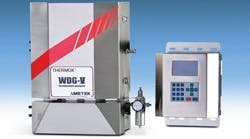"For more than 40 years, we have been a leader in combustion gas analysis," says Mike Fuller, divison VP of sales and marketing and business development for Ametek Process Instruments, "and we believe the WDG-V is the combustion analyzer of the future." WDG analyzers are based on a zirconium oxide cell that provides a reliable and cost-effective solution for measuring excess oxygen in flue gas as well as CO and methane levels. This information allows operators to obtain the highest fuel efficiency, while lowering emissions for NOx, CO and CO2. The zirconium oxide cell responds to the difference between the concentration of oxygen in the flue gas versus an air reference. To assure complete combustion, the flue gas should contain several percent oxygen. The optimum excess oxygen concentration is dependent on the fuel type (natural gas, hydrocarbon liquids and coal).
The WDG-V mounts directly to the process flange, and is heated to maintain all sample-wetted components above the acid dewpoint. Its air-operated aspirator draws a sample into the analyzer and returns it to the process. A portion of the sample rises into the convection loop past the combustibles and oxygen cells, and then back into the process.
"The role of combustion analyzers in control and safety functions is evolving rapidly," Fuller says. "Maximizing fuel efficiency, while reducing emissions from combustion processes, requires the use of aggressive operating setpoints that dictate the need for additional layers of safety for risk reduction." He adds, "The WDG-V was designed to meet the SIL-2 standard, so that it can be a key part of a safety instrumented system (SIS). The WDG's aspirator design has always provided a reasonable response time, but our customers needed tighter control on combustion parameters. This means faster response, even with flame arresters installed."
Fuller goes on, "The flow path through the WDG-V was completely redesigned, so it provides the fastest response of any extractive combustion gas analyzer, and it has the ability to predict a pending sensor failure and monitor flow characteristics to the sample cell."
The redesigned combustion analyzer features an improved aspirator with larger orifice sizes; low-flow sample alarm that monitors combustion gas flow and indicates low sample flow; automatic verification of cell and detector integrity ensuring proper accuracy and operation; and cell and detector age tracking for proactive calibration or service scheduling.
The WDG-V can be installed as either a standalone analyzer with analog/HART, discrete and Modbus RS-485 bi-directional communications, or supplied in a typical "sensor/controller" configuration with the addition of an AME Vision HMI that provides a graphical display and membrane keypad, Modbus, TCP/IP Ethernet connection, embedded web-enabled interface and USB data collection port.
"The WDG-V builds on the success of the WDG-IV by adding key customer-valued features," Fuller says. "The intuitive color graphical user interface on the AMEVision host module, which provides Modbus, TCP/IP, web-enabled interface and USB data port, is an Ametek Thermox first. The diagnostics that predict the lifetime of the sensor and the low-flow sample alarm that monitors combustion gas flow at the sensors set the WDG-V apart from previous generations. And the WDG-V is the first generation designed to be SIL-2 and part of a safety instrumented system implementation.
"Our design goal was to provide as much sensor and calibration performance monitoring, diagnostic self-checks and operational data as possible to the user through graphical display, data logging and digital communication. What we have been able to do is to provide a complete solution for combustion process control and safety. We can offer the end user all of the information required to implement predictive and proactive maintenance programs in addition to a highly reliable combustion analyzer."
For more information, contact Ametek Process Instruments at 412-828-9040 or www.ametekpi.com.




